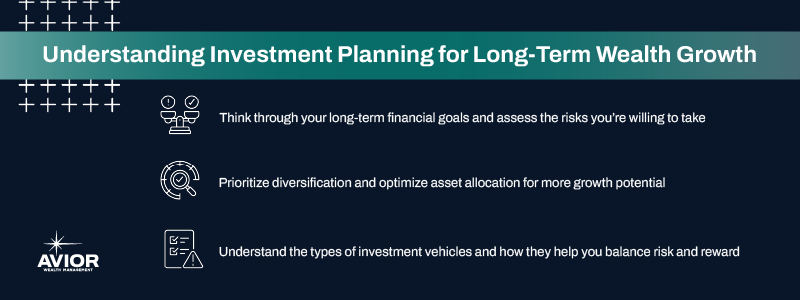Understanding Investment Planning for Long-Term Wealth Growth
Planning for long-term growth means carefully assessing goals, aligning your risk tolerance, and diversifying investments.

Investment planning is a driving component of your wealth management strategy. It encompasses how you allocate resources to optimize returns and manage risk.
Investing involves a comprehensive analysis of your financial goals, risk tolerance, and timeline, laying the foundation for more informed investment decisions. With thoughtful investment planning, you can align your financial resources with objectives such as retirement, education, or legacy preservation.
Strategic investment planning plays a major role in achieving sustained wealth growth by focusing on objectives and aligning investments with a carefully crafted strategy. Rather than relying on short-term market fluctuations, this approach emphasizes a long-term perspective.
Let’s look at how to effectively plan and manage investments to help you build and maintain wealth for the long term.
Identifying your goals and risk tolerance
Creating your investment foundation requires setting clear and realistic financial goals. They help provide direction and purpose to your financial decisions. These goals could be buying a home, funding education, saving for retirement, or creating an emergency fund.
Setting clear financial goals lies in the ability to prioritize, allocate resources efficiently, and stay motivated on the path to achieving these objectives. It provides a sense of purpose and helps you make informed decisions about saving, spending, and investing, fostering financial stability and success.
In addition, evaluating your risk tolerance supports more effective planning. What is your ability and willingness to withstand fluctuations in the value of your investments? Think through your emotional resilience and potential financial biases.
You can then determine the level of volatility you’re comfortable with and align your investment choices accordingly. Conservative investors may lean toward a higher allocation to fixed-income securities while aggressive investors may favor a larger allocation to equities.
A mismatch between risk tolerance and investment strategy can lead to stress, panic-selling during market downturns, or missed opportunities during market upswings. You want to construct a well-balanced and resilient investment portfolio that will hold up over time.
Prioritizing diversification and asset allocation
The way you allocate your assets is key for long-term financial success. It involves distributing your investment portfolio across different asset classes. The goal is to optimize the risk-return tradeoff by balancing investments with varying levels of risk and return potential. Asset allocation helps reduce portfolio volatility and enhance overall performance.
The concept of diversification factors in here. It involves spreading investments across each asset class strategically to further minimize risk. Diversifying across different industries, sectors, geographic regions, and types of investments can help protect against the risk of significant losses from the poor performance of a single investment. While diversification doesn’t eliminate risk, it reduces the impact of a poor-performing investment on the overall portfolio.
Here are a few examples of asset allocation tactics based on objectives and timelines:
- Short-term financial goals (those within the next three years):
For short-term goals, the preservation of capital is key. Focus on low-risk, liquid investments to minimize the impact of market volatility. Consider allocating a significant portion of your portfolio to cash equivalents, money market funds, and short-term bonds. Avoid exposure to highly volatile assets as there may not be sufficient time to recover from potential losses.
- Over the next three to five years:
Balancing growth and risk becomes more relevant for medium-term goals. Allocate a portion of your portfolio to a mix of conservative investments. Diversify to mitigate the risk associated with specific economic conditions.
- Long-term financial goals, five years plus:
For long-term goals, you can take on more risk for potential higher returns. Allocate a significant portion of your portfolio to growth-oriented assets like stocks, as they historically offer better returns over the long term. Diversify across domestic and international markets to capture global economic growth. Rebalance periodically as market conditions and investment performance evolve.
- Retirement planning:
As retirement is a long-term goal, a substantial allocation to equities is often recommended to benefit from compounding returns. Consider a mix of traditional and alternative investments to balance growth and income needs during retirement. Regularly review and adjust the asset allocation as retirement approaches to manage risk and liquidity.
Each of these timelines is critical for long-term wealth growth and sustainability. You may have objectives that apply to each bucket, so planning will help you manage them all in a holistic strategy.
Types of investment vehicles and their benefits
Now, when you’re considering your options, you need to understand the investment vehicles available to you and their pros and cons. Which will help you meet your longer-term objectives? This brief overview will help you explore investments:
Stocks
Investing in individual stocks means you buy shares of ownership in a company. These shares give you the potential for capital appreciation and dividends, as well as higher returns. The limitations are that they’re more volatile and you take on the risk of capital loss.
Bonds
Bonds are debt securities where you lend money to an issuer. You receive fixed-income payments and a return of the principal when the investment reaches maturity. Examples are U.S. Treasury Bonds and corporate bonds. The benefits are the fixed income and low risks but you deal with lower potential returns.
Mutual funds
Mutual funds are pooled funds managed by professional portfolio managers. With these, you can get more diversification across various securities and benefit from a professional managing the fund. However, be aware of management fees and potential capital gains tax.
Exchange-traded funds (ETFs)
ETFs are similar to mutual funds but traded on stock exchanges. They also provide diversification and liquidity, as well as lower expense ratios. You do have to deal with brokerage fees, though.
Understanding these investment vehicles helps you tailor your portfolio based on risk tolerance, financial goals, and preferences. Diversification across these options can enhance overall portfolio resilience in the long term.
Working with a financial expert for long-term financial performance
While mastering these basics about investment vehicles and aligning them to your risk tolerance and financial goals, remember that you’ll need to review your portfolio and rebalance as needed over time. You may need to make changes whenever something big in your life happens.
Seek guidance from financial advisors for personalized investment strategies. With an expert by your side through your planning process, your wealth management approach will factor in your goals, your appetite for risk, and the greater market.
Talk to the advisors at Avior for customized assistance in investment planning.
Disclaimer: Nothing contained herein should be construed as legal or tax advice. Avior and our Advisors will work with your attorney and/or tax professional to assist with your legal and tax strategies. Please consult your attorney or tax professional with specific legal and/or tax questions. Investment Management and Financial Planner are offered through Avior Wealth Management, LLC, an SEC-registered investment advisor. Past performance is not a guarantee of future results. Investments are subject to loss, including the loss of principal.
No Comments
Sorry, the comment form is closed at this time.




